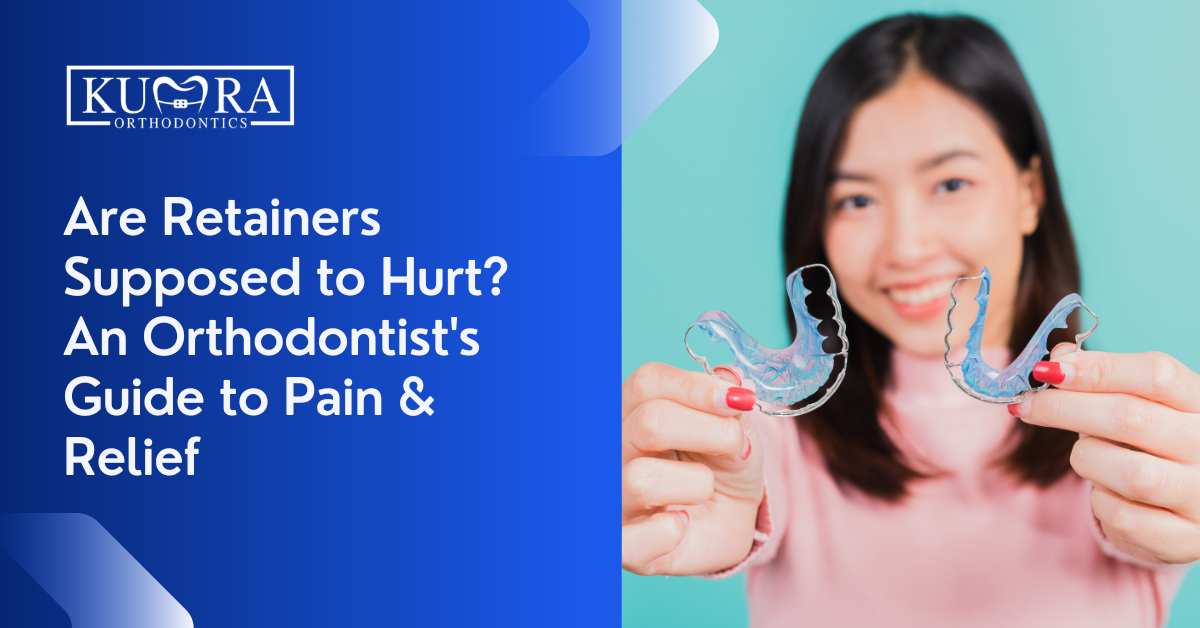You’ve finished your treatment, the braces are off, and you have a beautiful, straight smile. The hard part is over, right? Now you just have to wear your retainer. But when you pop it in, you feel an unexpected pain or pressure that immediately causes a wave of anxiety. Is this normal? Is something wrong with my teeth? Why do my retainers hurt? Is my expensive orthodontic work being undone?
If you’re asking, “are retainers supposed to hurt?” you’re not alone. Many patients experience some level of discomfort, and it can be difficult to know what’s a normal part of the process and what’s a sign of a real problem. As an orthodontist, my goal is to give you clarity and peace of mind.
This guide is designed to be the most thorough resource to help you understand the cause of your retainer pain, validate your experience, and find actionable steps to feel better. We’ll walk through everything from normal adjustment pressure to warning signs that mean you should call us.
The Short Answer: Differentiating Normal Pressure from Problematic Pain
For those in a hurry, it’s crucial to understand the difference between the expected sensation of a retainer doing its job and genuine pain that signals an issue.
[Video: A 60-second embedded video of Dr. Kumra explaining the difference between normal pressure and problematic pain, saying “Hi, I’m Dr. Kumra. Many of my patients ask this question. Let me quickly show you what’s normal and what’s not…”]
Here’s a quick breakdown:
| Normal Discomfort | Warning Sign Pain |
| A feeling of tightness or pressure | Sharp, shooting, or persistent pain |
| A general dull ache across the teeth | Pain that causes sores on your gums or cheeks |
| Discomfort that fades after a few days of consistent wear | Pain that affects your bite or makes it hard to close your mouth properly |
| Mild tenderness | Pain accompanied by a visible crack or damage to the retainer |
7 Common Reasons Your Retainer Hurts (And How to Identify Yours)
Retainer pain can stem from several sources. Let’s break down the most common reasons and help you identify which scenario applies to you.
It’s a Brand New Retainer
If you just received your retainer, some initial discomfort is completely normal. Think of it like the first day you got your braces or after an adjustment—your teeth need time to get used to the gentle pressure that’s holding them in their new, perfect position. This sensation should feel like pressure or a dull ache and typically subsides within 3-5 days of consistent wear.
You Haven’t Been Wearing It Consistently
This is one of the most common reasons for retainer pain. Your teeth are constantly under pressure from biting, chewing, and natural settling. Without the retainer holding them in place, they can shift slightly. Even missing just 24-48 hours of wear can allow for enough movement that your retainer feels uncomfortably tight when you put it back in. This is a crucial sign that your retainer is working hard to prevent your teeth from relapsing.
Your Teeth Are Still Shifting
Immediately after orthodontic treatment, your teeth, gums, and the underlying bone are still stabilizing in their new positions. This is called the “settling” period. Your retainer’s job is critical during this time to hold everything in place while the tissues firm up. The pressure you feel is the retainer resisting the natural tendency of your teeth to move.
Your Retainer is Damaged or Warped
Retainers are durable, but not indestructible. Dropping it on a hard surface, storing it improperly, or—a very common mistake—cleaning it with hot water can warp the plastic. A warped retainer will no longer fit correctly and can apply pressure in all the wrong places, causing significant pain. Inspect your retainer carefully for any visible cracks, bends, or changes in shape.
From the Doctor’s Chair: “I once had a patient in our Stafford office whose retainer fit perfectly until they cleaned it in boiling water. It warped just enough to cause serious discomfort. Never use hot water!”
Your Retainer Doesn’t Fit Properly
Sometimes, the issue isn’t with you or your teeth, but with the retainer itself. If the original mold or 3D scan of your teeth wasn’t perfectly accurate, or if there was an error during fabrication, the retainer might not fit as it should from day one. If the pain is sharp, localized to one spot, or doesn’t go away after the initial adjustment period, it could be a fit issue.
You Have a Buildup of Plaque on the Retainer
It might seem minor, but plaque and tartar can build up on your retainer just like they do on your teeth. Over time, this buildup can harden and essentially change the shape and fit of your retainer, causing it to feel tight and press uncomfortably against your teeth and gums.
There’s an Underlying Dental Issue
Occasionally, the pain isn’t caused by the retainer at all. Instead, the retainer might be pressing on a pre-existing but previously unnoticed dental problem, like a new cavity, a cracked tooth, or gum inflammation. If the pain is sharp, localized to a single tooth, and sensitive to temperature, it’s worth investigating.
Decoding Your Discomfort: Does the Type of Retainer Matter?
Yes, absolutely. The type of retainer you have can influence the kind of discomfort you might experience. At Kumra Orthodontics, we work with all types and understand their unique nuances.
Pain from Essix (Clear Plastic) Retainers
These retainers hug every surface of your teeth, so discomfort often feels like a generalized tightness. The most common issue is irritation from the edges. If the retainer wasn’t perfectly polished, the sharp plastic edge can rub against and cut your gums.
Pain from Hawley (Wire) Retainers
With Hawley retainers, the pressure is typically concentrated on the front teeth where the wire rests. The acrylic plate on the roof of your mouth can also cause some soreness initially. Sometimes, the wire can poke or rub against the inside of your cheeks or lips, causing irritation.
Discomfort from Permanent (Bonded) Retainers
While you don’t have to worry about the pressure of taking it in and out, bonded retainers present their own challenges. Food and plaque can get trapped around the wire, leading to gum inflammation and tenderness. The wire can also irritate your tongue. Proper flossing is essential to prevent this.
Your At-Home Retainer Pain Relief Toolkit
For normal discomfort, you don’t have to just tough it out. Here are some safe and effective ways to find relief at home.
- OTC Pain Relievers: Over-the-counter pain medication can be very effective. Pro-Tip: We typically suggest acetaminophen (Tylenol) over ibuprofen (Advil) initially, as some studies suggest NSAIDs may slightly slow tooth movement.
- Soft/Cold Foods: Stick to softer foods like yogurt, smoothies, and soup for a day or two to avoid putting extra pressure on your tender teeth. Cold foods and drinks can also help numb the area.
- Cold Compresses/Ice Packs: Applying a cold pack to your cheeks for 10-15 minutes can help reduce inflammation and dull the ache.
- Saltwater Rinses: Rinsing with a warm saltwater solution (1/2 teaspoon of salt in a glass of warm water) can soothe sore gums and any irritation inside your mouth.
- Dental Wax: If a wire on a Hawley retainer or the edge of an Essix retainer is rubbing a sore spot, a small piece of orthodontic wax can provide a smooth barrier and instant relief.
- Proper Cleaning: Gently brushing your retainer daily prevents buildup that can cause a poor fit. The American Association of Orthodontists provides excellent guidance on keeping your retainer clean.
When to Call the Orthodontist: A 3-Step Triage Guide
This is the most critical question. Use this simple, step-by-step guide to decide on your next move.
Watch & Wait (The First 48 Hours)
This is for: New retainers or minor tightness after inconsistent wear.
Your Action: Wear your retainer consistently as prescribed and use the at-home toolkit above for relief. The discomfort should gradually decrease over two days. If you don’t wear your retainer as prescribed, your teeth may shift so much it no longer fits.
Schedule a Non-Urgent Appointment If…
This is for: Discomfort that is manageable but persistent.
Your Action: Call our office to schedule a check-up. Don’t wait for your next scheduled visit. Schedule an appointment if:
- Discomfort lasts for more than 5 days.
- You have a consistent sore spot from the retainer rubbing your gums or cheek.
- Your retainer feels loose or like it’s “popping” off your teeth.
- You notice a visible change in your bite.
Call Us Immediately For a Priority Visit If…
This is for: Signs of a significant problem with your teeth or retainer.
Your Action: This requires immediate attention. Call us for a priority appointment if:
- You experience sharp, shooting pain.
- You see a crack or broken wire on your retainer.
- Your bite feels significantly different or “off.”
- The retainer will not seat fully on your teeth, no matter how hard you try.
**If you’re experiencing any of these urgent issues in the Washington, DC, or Stafford, VA, areas—even if you’re not our current patient—your oral health is our priority. Contact us for a priority consultation.
Your Smile is Worth Protecting
The retention phase is the final, crucial step in your orthodontic journey. If pain or uncertainty about your retainer is causing you stress, the best thing you can do is get an expert opinion.
At Kumra Orthodontics, we can quickly diagnose the issue and ensure your smile remains both beautiful and comfortable. Whether you’re one of our patients or not, we welcome you to our Washington, DC, or Stafford, VA, offices for a consultation. Get the clarity and peace of mind you deserve.
Contact us today to book your appointment
Your Retainer Questions Answered (FAQ)
How long is retainer pain supposed to last?
Normal adjustment discomfort should only last for a few days, typically 3-5 days at most. If pain persists beyond a week, you should contact your orthodontist.
Can a tight retainer damage my teeth?
A retainer that is tight from slight tooth shifting is generally safe and is doing its job to move teeth back into alignment. However, a retainer that is warped or fits improperly can apply harmful forces. If you experience severe pain or the retainer doesn’t seem to fit at all, do not force it and call your orthodontist.
What happens if I stop wearing my retainer because it hurts?
Stopping wear is the worst thing you can do. It allows your teeth to continue shifting, potentially leading to a significant relapse of your orthodontic treatment. If your teeth move too much, you may require more extensive (and expensive) treatment to correct them again.
How do I clean my retainer to prevent fit issues?
Gently brush it daily with a soft toothbrush and water or a mild soap. You can also use retainer cleaning tablets. Avoid hot water, which can warp the plastic, and harsh chemicals. For bonded retainers, use floss threaders to clean underneath the wire. For a full guide, you can check out our retainer care instructions.



